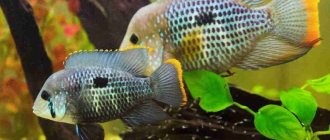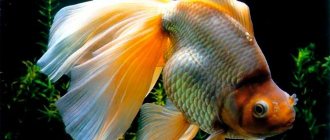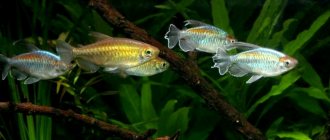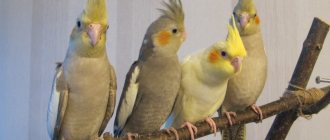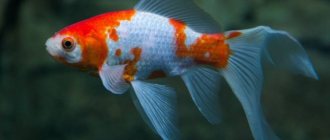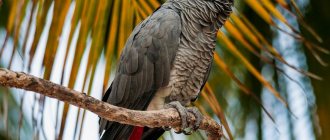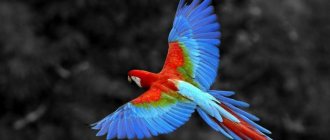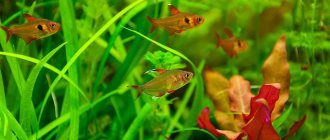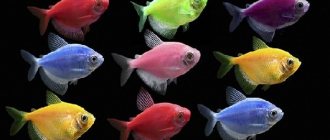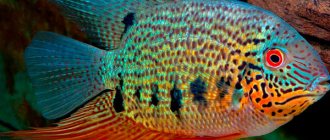Most fish from the cichlid genus belong to territorial species, which means their intolerant and aggressive behavior even towards their relatives, not to mention the rest of the inhabitants of the aquatic kingdom. However, among this unfriendly family there is also a completely peaceful representative called pelvicachromis, which is better known among aquarists as the parrotfish.
The parrot fish, unlike other representatives of cichlids, has a friendly character
Description of Pelvicachromis
Pelvicachromis is a very colorful fish, easy to care for and falls into the category of dwarf cichlids, which makes them very popular among people who are limited in the size of their aquarium or do not like large fish. Adult males do not exceed 10 cm, and females - no more than 7.5 cm.
One glance is enough to understand why the fish received the name “Parrotfish”. From Latin, the name of the fish is translated as “Pelva” - belly, “chromis” - color and “pulcher” - beautiful (beautiful).
Female Pelvicachromis can be identified by their shortened fins, the presence of a wider yellow stripe at the top of the dorsal fin and a rounded belly that turns bright red/purple during spawning season. Males have longer and thinner fins with distinct dark spots at the end. The color of males is less brilliant, especially the belly.
In general, the fish has a dark, wide stripe from nose to tail. In the rays of light, the scales shimmer with azure lights. The pelvic fins are red. The dorsal and caudal fins are decorated with a yellow border and dark round spots. The intensity of the color often depends on the mood.
Pelvicachromis pulcher is not the only species. Today, you can find various species, natural and selected morphs of pelvicachromis on sale. Here are some of them.
Banded parakeet (Pelvicachromis taeniatus), Boulenger, 1901.
Synonyms: Pelmatochromis kribensis Boulenger, 1911; P. kribensis var. calliptera; P. klugei Meinken, I960; P. kribensis klugei Meinken, 1965.
Variable species, has about 5 color natural morphs:
The male is olive to golden yellow in color, the scales of the upper body are dark-edged, and the abdomen is yellow, bluish to greenish. A dark stripe runs along the body. The dorsal fin is yellow to red, with a red and white border. The anal and pelvic fins are red-blue to dark blue at the base, then purple. The lower half of the caudal fin is streaked with violet-blue, the upper half has 2–4 black dots and a black-red border.
The female has a bluish-purple color of the abdomen, a dorsal fin with 1–2 black spots, a rounded tail with 1–2 black spots in its upper part.
Body length: 9 cm.
Water parameters in the aquarium: t 20 – 25 C; pH 5.4 – 7.5; dH 3 – 20.
Food: omnivore.
Habitat: Nigeria (Niger River Delta), Cameroon.
State of health and illness
Pelvicachromis pulcher are representatives of aquarium fish that naturally have good physical endurance. But they can also get sick if the living conditions in the aquarium are not organized correctly for them:
- Fish that, prior to acquisition, lived in another region or even country, will experience difficulties during the acclimatization period when changing water, which differs in the content of microelements, hardness and acidity in each area. In order for your aquarium pet to better tolerate new living conditions, it is not recommended to purchase fish that are too small. To purchase, you should choose individuals that have reached several centimeters in size.
- Overfeeding and unbalanced nutrition. Pelvicachromis pulcher is prone to obesity and dropsy. These diseases usually occur due to the fact that the fish are fed too often or the remaining food is not removed from the aquarium after feeding. It is very problematic to cure aquarium parrots from obesity or rid them of dropsy, so it is better to prevent the occurrence of these pathologies by providing the fish with the correct diet. Pelvicachromis pulcher can be lethargic and apathetic, and stop spawning as a result of an incorrectly selected diet. You need to feed your aquarium pets a varied and balanced diet; be sure to give them green vegetables – zucchini, cucumbers – at least once a week, so that they receive a sufficient amount of vitamins. A meager, monotonous diet will negatively affect the color of the fish: they will be dull and quickly lose their visual appeal.
- Lighting violation. If the light is very bright, the fish’s behavior and character may change, and not for the better. In bright light, pelvicachromis become nervous, rush around the aquarium, pester and bully their neighbors.
Yellow-bellied pelvicachromis humilis, Boulenger, 1916
The male is beige-gray with yellow gill covers and belly, 7–8 brown stripes across the body and red edging along the unpaired fins.
The female has a crimson belly, turquoise gills and a border along the top of the tail.
Body length: 13 cm.
Water parameters in the aquarium: t 24 – 27 C; pH 5.0 – 7.5; dH 0 – 12.
Food: omnivore.
Habitat: Southeast Guinea, Liberia, Sierra Leone.
Pelvicachromis aureocephalus, Meinken, 1960
Males are yellowish, the head and gill covers are greenish-golden, and a blackish stripe stretches from the eyes to the tail. The dorsal fin at the base is dark yellow-olive with a metallic gloss, dark red strokes in the direction of the fin rays, the back half of the fin is intensely red. The anal fin is pale purple, the ventral fins are light blue, the tail has 4 black spots and a red border.
The head and gill covers of females are glossy golden, the abdomen with a red-violet spot.
Body length: 10 cm.
Water parameters in the aquarium: t 24 – 27 C; pH 5.0 – 7.5; dH 0 – 12.
Food: omnivore.
Habitat: Nigeria.
Sex differences
It is quite easy to distinguish a female from a male, although for this they must be adults. The male has a wider and sloping head, and most importantly, he is much larger.
And the female is not only smaller, but she also has a noticeably more rounded abdomen, with a bright crimson spot.
Male (bottom) and female
Pelvicachromis camerunensis, 1962
Imported as Pelvicachromis pulcher, but has a more intense color. During the spawning period, males have a blood-red abdomen, chest and gill covers up to the lips. The lower part of the tail is yellowish. A dark stripe runs along the body; in the upper part of the body there are 3 light transverse stripes. The pelvic fins are red, with a blue edge in the male.
They mature at 9–12 months. Life expectancy in an aquarium is up to 8 years.
Body length: 10 cm.
Water parameters in the aquarium: t 22 – 26 C; pH 6.0 – 7.8; dH 6 – 20.
Food: omnivore.
Habitat: forest reservoirs of Southern Nigeria.
Roloff's parakeet (Pelvicachromis roloffi), Thys van den Audenaerde, 1968
The male is light purple, the back is gray-brown, and the belly is light. Depending on the condition of the fish, a dark stripe may run along the body. The unpaired fins are yellow-brown, the dorsal with numerous dark spots, the anal with a dark edge, the tail with a dark spot.
The female is grayish-brown with a purple tint, her abdomen is crimson. The unpaired fins are orange, the tail has 3-4 black dots with a white border. The pelvic fins are dark.
Life expectancy in an aquarium is up to 4 years.
Body length: 9 cm.
Water parameters in the aquarium: t 24 – 27 C; pH 5.0 – 7.5; dH 0 – 12.
Food: omnivore.
Habitat: Sierra Leone, eastern Guinea, Liberia.
Adviсe
- If the tank is located in the bedroom, pay attention to the noise from aquarium equipment. A noisy filter and compressor will be a serious problem.
- In water with a neutral pH level, offspring of different sexes will hatch in equal proportions. In more alkaline water, females predominate; in acidic water, males predominate.
- To prevent algae from appearing, do not allow sunlight to hit the walls of the aquarium. The water tank should be at least 1.5 meters from the windows. The shade of light should not be yellow.
- Always treat live food to avoid introducing parasites into the pond. A solution of potassium permanganate or methylene blue is suitable.
- To avoid stressing your pets, do not turn on the aquarium light right away. First turn on the lights in the room and let the fish get used to the changes. After this, turn on the aquarium lamp.
Pelvicachromis is also interesting because its color changes depending on its mood and well-being. During the spawning period, parrots become especially bright. If parrots are stressed, the colors become less saturated.
Previous
Fish14 popular viviparous aquarium fish
Next
Fish "Walking" catfish Clarias - a fish with a difficult temperament
Reticulated pelmatochromis (Pelvicachromis subocellatus), Gunther, 1871
The male is grayish-yellow with a dark mesh on the body. The pectoral fins are yellowish, the pelvic fins are black. The upper part of the caudal fin has a red border. The dorsal fin and the lower part of the caudal fin are red. Each scale is edged with red.
The female is smaller, plumper, has a yellowish color, unpaired fins with golden streaks. The abdomen and ventral fins are wine red. The fry is yellow-brown.
Body length: 10 cm.
Water parameters in the aquarium: t 23 – 27 C; pH 6.5 – 7.5; dH 5 – 20.
Food: omnivore.
Habitat: Western Africa, from Gabon to the mouth of the Congo.
Range and Habitat
Africa: southeastern Nigeria, as well as Western Cameroon and Eastern Benin.
Habitats in bodies of water with standing or slow-moving water in shallow water. Prefers areas of water bodies overgrown with dense vegetation mixed with open ground. Some populations exist in brackish conditions.
Albino morph of Pelvicachromis
Owners of albinos note the following feature - naturally colored males prefer albino females for mating, and all females prefer naturally colored males. Experts believe that the red belly, which is present in females ready to breed, acts as a magnet for males and appears better on albino females.
Striped pets, hybrids and albinos
Striped, or otherwise changeable parrot - The subspecies is characterized by the presence of 5 color forms at once. The scales are olive or golden with a dark border. The abdomen is green, blue or yellow. The color of the dorsal fin can be any shade ranging from red to yellow. In addition, it is decorated with red and white piping. Females have a purple belly with a blue tint.
The Blood Red Parrot is an American hybrid cichlid with a small mouth and a round, ball-like body. It can have the same even color (from barely noticeable yellowish to red) or a spotted “calico” pattern. Females are indistinguishable from males, but during spawning they lack pinkish areas around the gills and throat. Their eggs are sterile.
Of all the parrot species, albinos were the most difficult to create. This took specialists several decades. In the future, with natural colors during spawning, they give preference to albino friends. This is due to the fact that the change in belly color observed in female pelvicachromis ready to breed is much more noticeable if they are completely white.
Closely related species of parrot cichlids (even those that are similar in appearance) cannot produce common offspring in aquariums.
Conditions for keeping pelvicachromis
Pelvicachromis are completely unpretentious. They come from Africa, where the composition of the water can vary significantly. So the water in the lowlands is dark in color, acidic and very soft, while in the Niger Delta, for example, it is slightly brackish, more alkaline and much harder than in the streams that feed it.
In this regard, in order to most accurately determine the parameters of acidity and water hardness for the fish you purchased, you need to check with the seller the parameters of the water in the aquarium in which they were raised.
When keeping pelvicachromis, it is necessary to use sand or fine gravel of a dark color up to 3 mm and fill the aquarium with it to 3.5 - 5 cm.
The minimum volume is 50 liters, recommended from 80 and more. The size of the aquarium is very important especially when breeding and growing. We need shelter - caves.
As a material for creating caves, you can use stones of suitable shape, glued together with silicone or onto filters and super glue, like this.
The cave should be small, have only one entrance with minimal light transmission. As an alternative material, you can use clay or ceramic pots that do not contain chemicals and have smooth edges, as well as plastic tubes, coconut shells, and driftwood. When using PVC pipes, you need to cut a long piece and fix it in the substrate. And when using coconut shells, you need to break off a small piece of the shell - making an entrance, and put the shell sideways and press it to the substrate.
The presence of living plants will be useful and will serve as a good shelter, but it is worth keeping in mind that fish can dig up the roots of plants. You can easily use plastic aquarium plants , for example, often in pet stores, you can be surprised by plants from the Laguna company , which are perfect for decorating an aquarium with large cichlids.
Do not forget about regular weekly changes of 25 - 30% of the water, especially with dense planting. Filtration and aeration are required. The most important thing is that there are no excessive concentrations of nitrogen compounds and phosphates . This is the main problem for fish that beginners make. Ammonia, nitrite, nitrate, phosphates are the root cause of illness and death in pets. Every conscientious aquarist should always have a set of drop tests on hand, at least for nitrate and phosphate. Fortunately, they have now become inexpensive, there are no problems with their assortment and acquisition. For example, we can with a clear conscience recommend you the cool UHE drop tests, , but they are sold only online. In stores in your city - offline, you can find inexpensive Vladox tests .
When changing water, it would be useful to use clean water supply and use preparations that neutralize harmful substances. For example, Tetra AquaSafe - it removes chlorine compounds, heavy metals + contains B vitamins, iodine and other aquarium goodies. Those. With it, you can safely pour water into the aquarium without fear of harming your beloved pets.
Please note that a sharp change in the chemical parameters of water causes stress in fish, which in turn becomes one of the main pathogens of diseases.
Features of keeping and feeding parrotfish
Pelvikachromis pulcher are completely unpretentious fish to care for, so even a novice aquarist can keep them, since they will not cause much trouble or difficulty in keeping them. First of all, you need to select the appropriate container. The volume of the aquarium directly depends on whether the parrots will have neighbors and in what quantity.
The optimal size is calculated based on the fact that a pair of parrots will be comfortable in a 40 liter aquarium.
If there are neighbors, a larger tank will be required. Although fish are considered unpretentious to living conditions, they also need to maintain certain water parameters:
- temperature regime – +23° – +28°C;
- pH level – from 6.5 to 7.5, neutral;
- degree of hardness – should not exceed 15°.
In order to select optimal water parameters, you need to take into account the conditions in which the fish lived before moving into a new aquarium. As a rule, parrots born in the same region are already adapted to certain water parameters, so creating the necessary conditions for their comfortable life will not be difficult. If the fry were brought from another region or country, some difficulties may arise with their maintenance.
It is better to consider fine sand or gravel as a soil, since fish really like to rummage through it with their noses and dig up. Parrots are indifferent to the vegetation in the aquarium and do not cause much harm to it. Therefore, plants are selected solely according to the taste of the aquarist. But although pelvicachromis pulcher plants are not touched, it is still recommended to plant them in pots, because parrots periodically dig up the soil with their nose and can damage the root system of underwater crops.
In order for Pelvikachromis pulcher to feel as comfortable as possible in the aquarium, and for the conditions of keeping to be close to their natural habitat, the aquarium must have decorative elements that serve as shelter for the fish. It is recommended to put locks on the bottom, lay out jugs, and make grottoes out of driftwood. Various decorative shelters should be placed in the corners of the aquarium.
The tank must be covered with a lid, since parrots are nimble and very active fish, they move quickly in the water and can jump out, which will inevitably lead to injury and even death.
Lighting is required moderate, even dim. Parrots do not like bright light, in which they begin to behave too nervously. The aquarium must have an aeration and filtration system. In principle, you can do without a filter, but then the water must be changed more often. As practice shows, with a filter, the color of the fish becomes more saturated and intense.
Nutrition
Parrots are not only unpretentious in caring for and creating certain conditions in the aquarium, but also not picky in their diet. Representatives of this type of aquarium fish are omnivores, but the emphasis is still on live food, since in the wild, parrots, despite their modest size, are predatory fish.
Pelvikachromis have a tendency to obesity, so they need to be fed according to the regime.
You cannot leave leftover food in the aquarium; after 10 minutes you need to remove it from the surface of the water.
This will not only prevent aquarium inhabitants from overeating, but will also help keep the tank clean longer.
Parrots feed on live and frozen food. In addition, you can give them industrially produced food in the form of granules, flakes, and feed tablets. The best option for them are:
- bloodworm;
- daphnia;
- tubifex;
- Artemia;
- Cyclops.
Aquarists should be aware that the tubifex is not suitable for daily feeding. Although it is allowed for parrotfish, it is better to avoid it completely or give it extremely rarely. In addition, it is recommended to purchase it only in trusted places that have confirming quality certificates. Such recommendations are explained by the fact that tubifex worms can carry pathogens that cause various diseases in fish.
For immunity and good functioning of the digestive system, parrots should be periodically given vegetables, such as cucumbers and zucchini. It would also be useful to supplement with fortified food. It is recommended to feed food containing spirulina.
Pelvicachromis pulcher are fish that pick up food from the ground, so when feeding you need to make sure that the food settles to the bottom in sufficient quantity and is not eaten by its aquarium neighbors. Taking into account this specificity of feeding, at the beginning of spawning, when the fish will need increased nutrition and there are other inhabitants in the aquarium, it is recommended to place a couple of parrots in another tank.
A varied and balanced diet is what parrots need to feel good, be healthy, and have bright and rich colors.
Compatibility of Pelvicachromis
If you are going to keep pelvicachromis in a common aquarium, then choose your neighbors wisely, they should be peaceful and quite nimble, and the main thing is not to occupy the caves of pelvics, which should be in abundance for everyone. As neighbors we can recommend characins, barbs, zebrafish, rasboras, corydoras, gouramis, and various types of cichlids native to West Africa.
You certainly shouldn’t keep ancistrus and other loricariids with pelviks, which, like pelviks, love to dive and spawn in caches: twigs, coconuts and pots.
Like all cichlids, pelvicachromis are fast swimmers and can be aggressive, especially during the spawning period. Avoid overcrowding the aquarium.
Difficulties and specific content
Pelvicachromis pulcher is a species of aquarium fish, known for more than 2 centuries, during which experienced and novice aquarists kept them in their artificial reservoirs. The advantage of these fish is that they are completely unpretentious in care, especially when compared with other aquarium species. If all conditions of detention are observed, the diet and diet are correctly prepared, the fish will grow beautiful and healthy, the likelihood that they will get sick is minimal.
Difficulty may arise with the acquisition of this aquarium species, because, despite the fact that they have been known to aquarists for 2 centuries, today their popularity has fallen too much. Accordingly, finding these fish can be an overwhelming task.
The cost of one fish is approximately $1.
When purchasing a pair of parrots, you should not immediately put them into a common aquarium, especially if neighbors are waiting there. Even without acquaintance with other underwater inhabitants, fish may have a difficult adaptation period.
After purchasing fish, they must first be placed in a quarantine tank in which all water characteristics will be observed. In 2 weeks, the parrots will be able to adapt to new conditions in a calm environment. After the quarantine and adaptation period have passed, they can be placed in a large tank with other fish.
It is recommended to keep Pelvicachromis pulcher in schools of 8 to 10 pieces, but only on the condition that for such a number of fish an aquarium with a volume of 80 to 100 liters is allocated. Although aquarium parrots are quite modest in size, preferring to live at the bottom or in the middle column of water, they love space. If there is not enough space in the aquarium, the fish will begin to conflict with each other, due to the fact that they simply cannot divide the territory among themselves.
Comfortable conditions, a spacious tank, a high-quality and varied menu will allow parrots to grow healthy and delight their owners with bright, rich colors for a long time.
What to feed Pelvikachromis
It is not very difficult to please parrotfish in food. At the same time, a varied diet is the key to the health of your fish. Keep in mind: in nature, fish swim mainly near the bottom, so it would be a good idea to use sinking types of food. We recommend using high-quality food from Tetra.
It should be noted that when purchasing any dry food, you should pay attention to the date of its manufacture and shelf life, try not to buy food in bulk, and also store the food in a closed state - this will help to avoid the development of pathogenic flora in it.
Feeding
Feeding the Common Budgerigar Cichlid is very easy. They are omnivores and eat all types of food: live, frozen, artificial. It is best to feed cribensis a variety of fish, in addition to healthier fish, this also enhances its coloring.
You can feed: flakes, granules, tablets, bloodworms, tubifex, brine shrimp, daphnia, cyclops, vegetables such as cucumbers, or give special food with spirulina.
Remember that pelvicachromis feed from the bottom, and it is important that the food gets to them and is not intercepted by other fish in the middle layers of water.
If you want to get fry, then before spawning the parrots need to be fed generously with live food.
Breeding and propagation of Pelvicachromis
If you are planning to breed Pelvikachromis, then it is best to look for an already formed pair. However, you can also choose a pair from the fish you like in the store; Pelmatochromis form pairs quite well. They create pairs for life - there is no point in separating them. It is interesting that females of pelvicachromis are, as a rule, brighter in color than males. Female parrots (unlike most other cichlids - and most fish in general) are the "active party" in courtship. It is the females of Pelvikachromis that “seduce” the males, fight for them, choose and clean the nest...
Breeders noticed a very interesting feature - at pH 7.0, pelvicachromis produce offspring of approximately equal sex ratio. And soft, acidic water tends to produce more females, while more alkaline water tips the scales toward producing more males.
Pelvicachromis reach sexual maturity at 6 months (females mature earlier than males). During spawning and courtship for fry, the fish become very aggressive. During the mating season, the fish are generously fed with live food. The color of the fish will become more intense as they are ready to mate. In most cases, females will proactively show bright belly color. At this moment, females are the most aggressive. Pairs can often be seen moving soil out of the cave shortly before spawning, preparing the cave for their young. Once the pair has prepared their nest, spawning begins. The female can lay 200 to 300 eggs at a time. From the moment the clutch appears until the free-swimming fry appear, the female will remain in the cave, coming out only to quickly feed. At this time, the male patrols the property near the cave, protecting the female and offspring.
Caring for the fry is not very difficult. When the fry are kept at a temperature of 29 0C, the fish begin to swim freely within a week. At this moment, barely visible fry can be observed on the surface of the ground. When leaving the cave, they stay close to their parents. In some cases, one parent will care for the offspring while keeping the other away. The fry should be fed with freshly hatched brine shrimp, ground dry food, or special commercial food for fry several times a day.
During this period, it is necessary to do frequent water changes, taking into account the constant feeding of the fish. If this is not done, then poisons - ammonia, nitrites and nitrates can destroy the younger generation. After 2 - 4 weeks, the fry will be approximately a little over a centimeter in size and can be safely separated from their parents. By two months, the dotted pattern on the body of the fry is replaced by horizontal black stripes. The habits and colors of adults and fry acquire by 4 months.
Author Alexander Isakov
Editor V. Chernyavsky
O. Matsevich
Reproduction of parrot cichlids
Under the right and comfortable conditions, “parrots” reproduce well in captivity. Fish, as a rule, spawn in a common aquarium, but experts recommend that for these purposes you should still transplant partners into a separate container.
Sexual maturity in Pelvicachromis occurs at approximately 9–11 months. Parrot cichlids belong to a peculiar category of monogamous people, which is why they form pairs for life. When the appropriate period approaches, the male selects a suitable shelter, after which mating games begin: both partners acquire even brighter colors and characteristically move in front of each other. Such courtship lasts about a week, after which the female enters the prepared shelter and lays eggs, then the male swims there and fertilizes them.
Sexual maturity in Pelvicachromis occurs at approximately 9–11 months.
For 2-4 days, the female is constantly in the cave with eggs, only occasionally swimming out to have a snack. The male keeps watch outside all the time.
It happens that young couples, due to inexperience, eat the entire litter, so some breeders immediately transfer the clutch to the incubator.
After 4-5 days, small larvae appear from the eggs, which sink to the bottom and lie there for another 3-4 days, after which they form into fry and swim out of the shelter together with their parents. As a rule, “parrots” are very caring parents, however, the principles of natural selection take their toll, and from a third to half of the offspring die in the first months.


